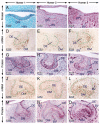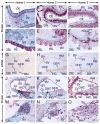Distinct and Overlapping Expression Patterns of the Homer Family of Scaffolding Proteins and Their Encoding Genes in Developing Murine Cephalic Tissues
- PMID: 32070057
- PMCID: PMC7072945
- DOI: 10.3390/ijms21041264
Distinct and Overlapping Expression Patterns of the Homer Family of Scaffolding Proteins and Their Encoding Genes in Developing Murine Cephalic Tissues
Abstract
In mammals Homer1, Homer2 and Homer3 constitute a family of scaffolding proteins with key roles in Ca2+ signaling and Ca2+ transport. In rodents, Homer proteins and mRNAs have been shown to be expressed in various postnatal tissues and to be enriched in brain. However, whether the Homers are expressed in developing tissues is hitherto largely unknown. In this work, we used immunohistochemistry and in situ hybridization to analyze the expression patterns of Homer1, Homer2 and Homer3 in developing cephalic structures. Our study revealed that the three Homer proteins and their encoding genes are expressed in a wide range of developing tissues and organs, including the brain, tooth, eye, cochlea, salivary glands, olfactory and respiratory mucosae, bone and taste buds. We show that although overall the three Homers exhibit overlapping distribution patterns, the proteins localize at distinct subcellular domains in several cell types, that in both undifferentiated and differentiated cells Homer proteins are concentrated in puncta and that the vascular endothelium is enriched with Homer3 mRNA and protein. Our findings suggest that Homer proteins may have differential and overlapping functions and are expected to be of value for future research aiming at deciphering the roles of Homer proteins during embryonic development.
Keywords: ameloblasts; choroid plexus; cochlea; endothelium; hippocampal formation; hypothalamus; odontoblasts; olfactory epithelium; salivary glands; taste buds.
Conflict of interest statement
The authors declare no conflict of interest.
Figures







Similar articles
-
Differential expression of Homer family proteins in the developing mouse brain.J Comp Neurol. 2004 Jun 7;473(4):582-99. doi: 10.1002/cne.20116. J Comp Neurol. 2004. PMID: 15116392
-
Diagnostic Potential of Differentially Expressed Homer1 and Homer2 in Ischemic Stroke.Cell Physiol Biochem. 2016;39(6):2353-2363. doi: 10.1159/000447927. Epub 2016 Nov 11. Cell Physiol Biochem. 2016. PMID: 27832625
-
Effects of two inhibitors of metabolic glutamate receptor 5 on expression of endogenous homer scaffold protein 1 in the auditory cortex of mice with tinnitus.Bioengineered. 2021 Dec;12(1):7156-7164. doi: 10.1080/21655979.2021.1979354. Bioengineered. 2021. PMID: 34546852 Free PMC article.
-
Homer proteins in Ca²⁺ entry.IUBMB Life. 2013 Jun;65(6):497-504. doi: 10.1002/iub.1162. Epub 2013 Apr 3. IUBMB Life. 2013. PMID: 23554128 Review.
-
Homer protein family regulation in skeletal muscle and neuromuscular adaptation.IUBMB Life. 2013 Sep;65(9):769-76. doi: 10.1002/iub.1198. Epub 2013 Aug 5. IUBMB Life. 2013. PMID: 23913637 Review.
Cited by
-
HOMER3 promotes non-small cell lung cancer growth and metastasis primarily through GABPB1-mediated mitochondrial metabolism.Cell Death Dis. 2023 Dec 11;14(12):814. doi: 10.1038/s41419-023-06335-5. Cell Death Dis. 2023. PMID: 38081871 Free PMC article.
-
HOMER3 facilitates growth factor-mediated β-Catenin tyrosine phosphorylation and activation to promote metastasis in triple negative breast cancer.J Hematol Oncol. 2021 Jan 6;14(1):6. doi: 10.1186/s13045-020-01021-x. J Hematol Oncol. 2021. PMID: 33407765 Free PMC article.
-
A Novel Truncating Mutation in HOMER2 Causes Nonsyndromic Progressive DFNA68 Hearing Loss in a Spanish Family.Genes (Basel). 2021 Mar 12;12(3):411. doi: 10.3390/genes12030411. Genes (Basel). 2021. PMID: 33809266 Free PMC article.
-
Loss of BMP2 and BMP4 Signaling in the Dental Epithelium Causes Defective Enamel Maturation and Aberrant Development of Ameloblasts.Int J Mol Sci. 2022 May 29;23(11):6095. doi: 10.3390/ijms23116095. Int J Mol Sci. 2022. PMID: 35682776 Free PMC article.
-
Novel Heredity Basis of the Four-Horn Phenotype in Sheep Using Genome-Wide Sequence Data.Animals (Basel). 2023 Oct 10;13(20):3166. doi: 10.3390/ani13203166. Animals (Basel). 2023. PMID: 37893889 Free PMC article.
References
-
- Xiao B., Tu J.C., Petralia R.S., Yuan J.P., Doan A., Breder C.D., Ruggiero A., Lanahan A.A., Wenthold R.J., Worley P.F. Homer regulates the association of group I metabotropic glutamate receptors with multivalent complexes of homer-related, synaptic proteins. Neuron. 1998;21:707–716. doi: 10.1016/S0896-6273(00)80588-7. - DOI - PubMed
-
- Shiraishi Y., Mizutani A., Bito H., Fujisawa K., Narumiya S., Mikoshiba K., Furuichi T. Cupidin, an isoform of Homer/Vesl, interacts with actin cytoskeleton and activates Rho family of small GTPases and is expressed in developing mouse cerebellar granule cells. J. Neurosci. 1999;19:8389–8400. doi: 10.1523/JNEUROSCI.19-19-08389.1999. - DOI - PMC - PubMed
MeSH terms
Substances
Grants and funding
LinkOut - more resources
Full Text Sources
Medical
Molecular Biology Databases
Miscellaneous

